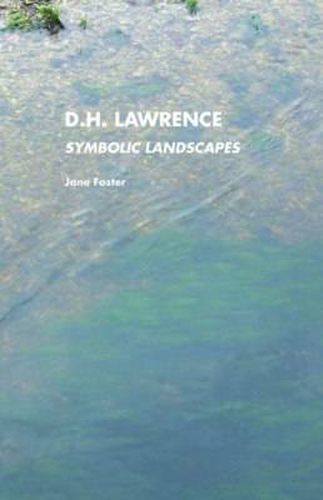Readings Newsletter
Become a Readings Member to make your shopping experience even easier.
Sign in or sign up for free!
You’re not far away from qualifying for FREE standard shipping within Australia
You’ve qualified for FREE standard shipping within Australia
The cart is loading…






This title is printed to order. This book may have been self-published. If so, we cannot guarantee the quality of the content. In the main most books will have gone through the editing process however some may not. We therefore suggest that you be aware of this before ordering this book. If in doubt check either the author or publisher’s details as we are unable to accept any returns unless they are faulty. Please contact us if you have any questions.
D.H. LAWRENCE: SYMBOLIC LANDSCAPES This book analyzes the rich discourses of mythology, symbolism, form, eroticism and landscape in D.H.Lawrence’s fiction. Jane Foster traces Lawrence’s symbols (tigers, suns, fish, peacocks) in many of the short stories, as well as the major novels. ‘Spirit of place’ was always important for Lawrence, and Foster’s study investigates how Lawrence’s concept of place informed his fiction, poetry and travel books. EXTRACT Lawrence uses many traditional poetic symbols - flowers, fire, the Moon - but there are some symbols that he has made very much his own: blood, rivers, the phallus, rainbow and the Lawrencean bestiary: horse, phoenix, peacock, dragon, snake, lion, tiger, rabbit and fish. The Lawrencean animals are the most alive of living symbols. There are many symbolic beasts in the poems too: fish, tortoises, snakes, eagles, elephants, mosquitoes, goats, etc. ***** D.H. Lawrence probably uses more flowers in his art than any other comparable writer. The poems are full of flowers - irises, violets, roses, campions - all kinds of flowers, hundreds of flowers, blossoms and plants. He fills his books with flowers rather like the Early Netherlandish painters filled their paintings of the Madonna with heaps of flowers. Lawrence uses flower symbolism to underpin the action and the emotional states of his characters. Ursula, for instance, delights, as Connie Chatterley does, in flowers. They remind her of the beauty of the world when the pain of love becomes too much. In Women in Love, Ursula is transported, to use the old term, by some daisies floating in water: She went along the bank towards the sluice. The daisies were scattered broadcast on the pond, tiny radiant things, like an exaltation, points of exaltation here and there. Why did they move so strongly and mystically? Look, he said, your boat of purple paper is escorting them, and they are a convoy of rafts. Some of the daisies came slowly towards her, hesitating, making a shy, bright little cotillion on the dark clear water. Their gay, bright candour moved her so much as they came near, that she was almost in tears. Why are they so lovely? she cried. Why do I think them so lovely? With illustrations, bibliography and notes.
$9.00 standard shipping within Australia
FREE standard shipping within Australia for orders over $100.00
Express & International shipping calculated at checkout
This title is printed to order. This book may have been self-published. If so, we cannot guarantee the quality of the content. In the main most books will have gone through the editing process however some may not. We therefore suggest that you be aware of this before ordering this book. If in doubt check either the author or publisher’s details as we are unable to accept any returns unless they are faulty. Please contact us if you have any questions.
D.H. LAWRENCE: SYMBOLIC LANDSCAPES This book analyzes the rich discourses of mythology, symbolism, form, eroticism and landscape in D.H.Lawrence’s fiction. Jane Foster traces Lawrence’s symbols (tigers, suns, fish, peacocks) in many of the short stories, as well as the major novels. ‘Spirit of place’ was always important for Lawrence, and Foster’s study investigates how Lawrence’s concept of place informed his fiction, poetry and travel books. EXTRACT Lawrence uses many traditional poetic symbols - flowers, fire, the Moon - but there are some symbols that he has made very much his own: blood, rivers, the phallus, rainbow and the Lawrencean bestiary: horse, phoenix, peacock, dragon, snake, lion, tiger, rabbit and fish. The Lawrencean animals are the most alive of living symbols. There are many symbolic beasts in the poems too: fish, tortoises, snakes, eagles, elephants, mosquitoes, goats, etc. ***** D.H. Lawrence probably uses more flowers in his art than any other comparable writer. The poems are full of flowers - irises, violets, roses, campions - all kinds of flowers, hundreds of flowers, blossoms and plants. He fills his books with flowers rather like the Early Netherlandish painters filled their paintings of the Madonna with heaps of flowers. Lawrence uses flower symbolism to underpin the action and the emotional states of his characters. Ursula, for instance, delights, as Connie Chatterley does, in flowers. They remind her of the beauty of the world when the pain of love becomes too much. In Women in Love, Ursula is transported, to use the old term, by some daisies floating in water: She went along the bank towards the sluice. The daisies were scattered broadcast on the pond, tiny radiant things, like an exaltation, points of exaltation here and there. Why did they move so strongly and mystically? Look, he said, your boat of purple paper is escorting them, and they are a convoy of rafts. Some of the daisies came slowly towards her, hesitating, making a shy, bright little cotillion on the dark clear water. Their gay, bright candour moved her so much as they came near, that she was almost in tears. Why are they so lovely? she cried. Why do I think them so lovely? With illustrations, bibliography and notes.